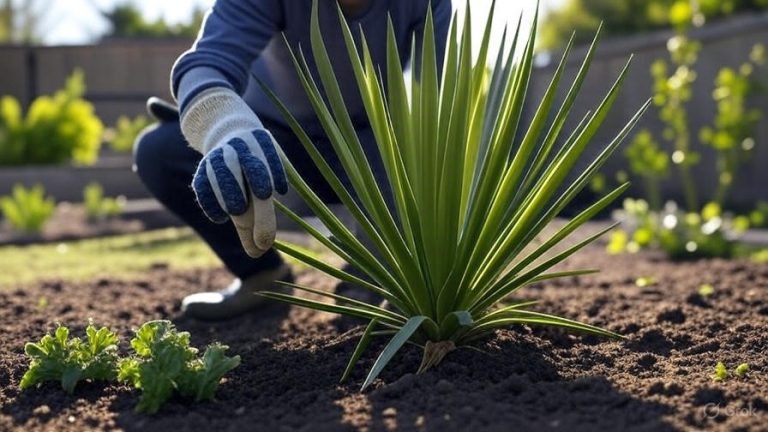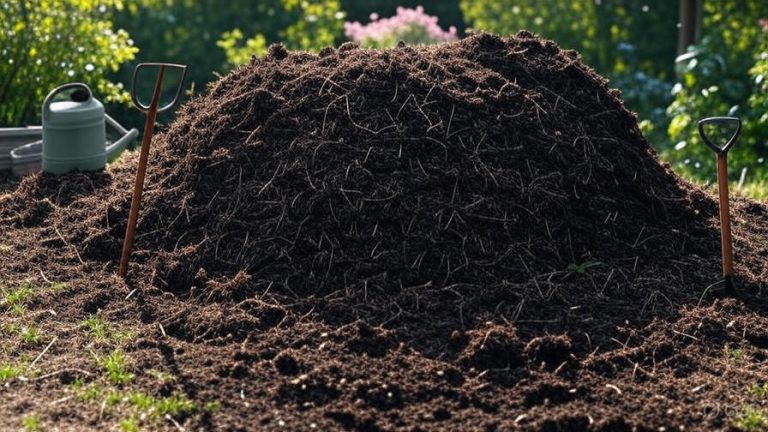How to Get Rid of Mushrooms in Your Yard?
You walk outside one morning with your coffee, ready to admire your beautiful lawn. Then you see them. Dozens of mushrooms popping up overnight like uninvited guests at a party. Your once-pristine yard now looks like a fungi farm.
Sound familiar? You’re not alone. Thousands of homeowners battle mushrooms in their grass every year. The good news is that getting rid of lawn mushrooms isn’t as complicated as you might think.
This guide will show you exactly how to eliminate mushrooms from your yard and keep them from coming back. No fluff, no confusing science talk. Just practical solutions that actually work.
Why Mushrooms Grow in Your Lawn
Before we jump into removal methods, let’s talk about why these fungi keep appearing in your grass.
Mushrooms are like the tip of an iceberg. The real action happens underground. A massive network of fungal threads called mycelium lives in your soil. When conditions are right, this network produces mushrooms to spread spores.
Three main factors trigger mushroom growth in yards:
Excess Moisture – Mushrooms love wet environments. Overwatering your lawn, poor drainage, or heavy rainfall creates the perfect conditions for fungi to thrive. If your soil stays damp for days after watering or rain, you’re basically rolling out the red carpet for mushrooms.
Decaying Organic Matter – Dead tree roots, buried wood chips, old mulch, pet waste, and decomposing grass clippings all feed the fungal network underground. The mycelium breaks down this organic material, and mushrooms pop up as part of this natural decomposition process.
Shade and Poor Air Circulation – Areas under trees, along fences, or in corners of your yard that don’t get much sunlight are prime real estate for mushrooms. These spots stay darker and hold moisture longer than sunny areas.
The fungi living in your soil aren’t actually harmful to your grass. In fact, they’re breaking down organic matter and returning nutrients to the soil. But let’s be honest – nobody wants a yard full of mushrooms.
Are Mushrooms in Your Yard Dangerous?
This is the first question most people ask, and it’s a smart one.
Many yard mushrooms are harmless to your lawn. Some are even beneficial, helping to aerate the soil and break down organic debris. However, several varieties are toxic to humans and animals.
The problem is that identifying mushroom species is incredibly difficult. Even experts sometimes struggle to tell poisonous varieties from safe ones. A single yard can host multiple mushroom types at once.
If you have kids or pets who spend time in your yard, treat all mushrooms as potentially dangerous. Dogs and cats are naturally curious and might nibble on mushrooms while playing outside. Some toxic varieties can cause serious illness or worse.
Common poisonous mushrooms found in lawns include death caps, false parasols, and certain types of Chlorophyllum species. These can look remarkably similar to harmless varieties.
The safest approach? Remove all mushrooms from your yard as soon as you spot them. Don’t take chances with your family’s health.
Quick Methods to Remove Mushrooms from Your Lawn
Let’s start with the fastest ways to clear mushrooms from your grass. These methods provide immediate results, though they won’t prevent new mushrooms from growing back.
Hand Picking and Physical Removal
The simplest method is also one of the most effective for small infestations. Put on a pair of gloves (never touch unknown mushrooms with bare hands) and pluck them right out of the ground.
Grab each mushroom at the base and pull firmly but gently. You want to remove as much of the stem as possible. Don’t twist or break the mushroom cap, as this can release thousands of spores into your yard.
Drop the mushrooms into a sealed plastic bag as you collect them. Don’t toss them into your compost pile or leave them on the lawn. The spores will just spread and create more mushrooms.
After collecting all visible mushrooms, tie the bag tightly and throw it in the trash. Wash your gloves thoroughly with soap and hot water. If you used bare hands (which you shouldn’t), scrub your hands well before touching your face or eating.
This method works great for occasional mushrooms or small clusters. If you have hundreds of mushrooms covering large areas, you’ll need a different approach.
Mowing Over Mushrooms
When you have too many mushrooms to pick by hand, your lawn mower becomes your best friend. Set your mower to a high setting and cut right over the mushrooms.
This method chops up the mushroom caps and scatters the pieces, which will decompose quickly. Yes, it does spread spores around your yard. But here’s the thing – spores are already everywhere in the air. Mowing won’t significantly increase your mushroom problem.
The real benefit of mowing is that it keeps your yard looking presentable while you work on long-term solutions. It’s also incredibly fast compared to hand-picking hundreds of mushrooms.
Mow in a different direction than usual to reach mushrooms from all angles. Bag your grass clippings if possible, especially if the mushrooms are particularly numerous. This removes some of the fungal material from your yard.
Clean your mower deck after cutting through a heavy mushroom patch. A hose and stiff brush will do the job. You don’t want to spread fungal spores to other parts of your property or your neighbor’s yard.
Raking and Debris Removal
This step often gets overlooked, but it’s crucial for long-term mushroom control. Rake your entire yard thoroughly, paying special attention to areas where mushrooms keep appearing.
Pull up dead grass, fallen leaves, twigs, and any other organic debris. This material feeds the fungal network underground. Removing it starves the mycelium and reduces future mushroom growth.
Look for hidden sources of organic matter too. Check under bushes, around tree bases, and along your fence line. These spots collect debris that most people never notice.
After raking, bag everything up and dispose of it in your trash or yard waste bin. Don’t compost this material unless your compost pile reaches high enough temperatures to kill fungal spores (at least 140°F).
Do this deep raking every few weeks during mushroom season. Regular removal of organic debris makes a huge difference in controlling fungal growth.
Long-Term Solutions to Prevent Mushrooms
Now let’s tackle the root cause of your mushroom problem. These strategies target the conditions that allow fungi to thrive in your yard.
Fix Your Watering Habits
Overwatering is the number one cause of persistent mushroom problems. Most lawns need far less water than people think.
Water your grass deeply but infrequently. Give your lawn about one inch of water per week, including rainfall. This encourages deep root growth and allows the soil surface to dry between waterings.
Water early in the morning, between 6 AM and 10 AM. This timing gives grass blades time to dry before nightfall. Wet grass overnight invites fungal problems beyond just mushrooms – diseases and mold love those conditions too.
Install a rain gauge in your yard to track how much water your lawn receives. Many people water on a fixed schedule without checking if rain has already done the job for them.
If certain areas of your yard stay soggy long after watering, you have a drainage issue that needs addressing. We’ll cover that next.
Improve Soil Drainage
Poor drainage creates the constantly moist conditions that mushrooms love. If puddles form in your yard after rain or watering, you need to improve water flow.
Aerate your lawn once or twice a year. This process pulls small plugs of soil from your yard, creating channels for water to move through compacted ground. You can rent a core aerator from most home improvement stores.
The best time to aerate is during your grass’s peak growing season. For cool-season grasses, that’s early spring or fall. For warm-season grasses, late spring or early summer works best.
After aerating, spread a thin layer of compost or sand across your lawn. This topdressing fills the holes and improves soil structure over time. Better soil structure means better drainage and fewer mushrooms.
For seriously bad drainage problems, you might need to install a French drain or regrade parts of your yard. These are bigger projects, but they solve drainage issues permanently.
Remove Underground Organic Matter
Remember those buried wood chips and dead tree roots I mentioned earlier? They’re feeding the fungal network that produces your mushrooms.
If you recently removed a tree from your yard, the old root system is probably still decomposing underground. This can fuel mushroom growth for years. Consider having a tree service grind out the stump and major roots.
Old construction debris is another common culprit. Some builders bury wood scraps, cardboard, and other organic material during landscaping. These hidden treasures create hot spots for mushroom growth.
If mushrooms consistently appear in the same spots, dig down a few inches to see what’s underneath. You might find rotting wood or other debris. Remove it completely.
After removing buried organic matter, fill the holes with fresh topsoil. Tamp it down firmly and overseed the area if needed.
Reduce Shade and Improve Air Flow
Mushrooms struggle in sunny, well-ventilated areas. They prefer the cool, damp conditions found in shady spots.
Trim tree branches that hang over your lawn, especially low-hanging limbs that block sunlight. This allows more light to reach your grass and helps the soil dry out faster.
Prune shrubs and bushes to improve air circulation around your yard. Dense plantings trap moisture and create ideal conditions for fungi.
If you have a solid fence, consider switching to a style with gaps between boards. This allows wind to flow through and helps dry out damp areas along your fence line.
Can’t remove the shade? Plant shade-tolerant grass varieties in those areas. These grasses grow thicker in low light, which helps crowd out mushrooms and other unwanted growth.

Natural Remedies to Kill Mushrooms
Some people prefer natural solutions over chemical treatments. Here are a few options that can help control mushrooms without harsh fungicides.
Vinegar Solution
White vinegar acts as a natural fungicide. Mix one part vinegar with four parts water in a spray bottle. Spray directly on mushrooms and the surrounding soil.
The acetic acid in vinegar damages the mushroom’s cell structure and kills it quickly. You’ll see results within a day or two.
Be careful with this method. Vinegar will also damage or kill your grass if you spray too much. Use it sparingly and only on the mushrooms themselves, not broadcast across your entire lawn.
This solution works best for spot-treating small mushroom patches. For large infestations, you’ll need a different approach.
Baking Soda Treatment
Baking soda raises soil pH, creating conditions that many fungi dislike. Mix three tablespoons of baking soda with one gallon of water.
Pour this mixture over areas where mushrooms grow frequently. The baking soda alters the soil chemistry and can discourage fungal growth.
This method takes longer to show results than vinegar. You might need to apply it weekly for several weeks before seeing a significant reduction in mushrooms.
Test your soil pH before using baking soda extensively. Most grass types prefer slightly acidic soil (pH 6.0-7.0). Too much baking soda can make your soil too alkaline and harm your grass.
Dish Soap Solution
A simple mixture of dish soap and water can help control mushrooms by breaking down their waxy coating. Mix two tablespoons of liquid dish soap into two gallons of water.
Spray this solution on mushrooms and the immediate area around them. The soap penetrates the mushroom’s protective layer and dries it out.
This method is gentle enough that it won’t harm your grass, but it’s also less effective than vinegar or commercial fungicides. Think of it as a mild deterrent rather than a knockout punch.
Repeat applications every few days until the mushrooms stop appearing in treated areas.
Chemical Fungicide Options
When natural methods aren’t cutting it, commercial fungicides offer more powerful solutions. These products are specifically designed to kill fungi and prevent regrowth.
Types of Lawn Fungicides
Fungicides come in two main categories: contact and systemic.
Contact fungicides sit on the surface and kill mushrooms on contact. They work quickly but don’t protect against new growth. You’ll need to reapply them regularly throughout mushroom season.
Systemic fungicides are absorbed by grass and soil. They provide longer-lasting protection by creating an environment where fungi can’t thrive. These products cost more but require fewer applications.
Look for fungicides containing active ingredients like azoxystrobin, propiconazole, or myclobutanil. These compounds are effective against the fungi that produce lawn mushrooms.
How to Apply Fungicides Safely
Always read and follow the product label instructions exactly. Fungicides are pesticides and require careful handling.
Wear protective gear including gloves, long sleeves, and eye protection. Apply fungicides on a calm day when no rain is forecast for at least 24 hours.
Water your lawn lightly before applying fungicide. This helps the product penetrate the soil where the fungal network lives.
Use a garden sprayer or spreader to apply the fungicide evenly across affected areas. Don’t just spray visible mushrooms – treat the entire area where they grow.
Keep kids and pets off the lawn until the product dries completely. Most fungicides are safe once dry, but check your specific product’s label for timing.
Expect to apply fungicides multiple times throughout the growing season. One application rarely solves the problem permanently.
Dealing with Fairy Rings
Fairy rings are those annoying circles of mushrooms that appear in lawns. They’re caused by a specific type of fungi that spreads outward in a ring pattern from a central point.
These rings are particularly stubborn. The mycelium grows so thick underground that it actually becomes water-repellent. The grass inside the ring often dies or turns brown from lack of moisture.
To treat fairy rings, you need to break up the water-repellent layer. Use a core aerator to punch holes throughout the affected area. Make multiple passes in different directions.
After aerating, soak the area thoroughly with water. You might need to water daily for a week or two to rehydrate the soil. Add a wetting agent (available at garden centers) to help water penetrate the water-repellent layer.
For severe fairy rings, you might need to excavate the soil. Dig down about 12 inches and remove all the affected soil. Replace it with fresh topsoil and reseed.
This is labor-intensive but often the only way to eliminate persistent fairy rings. Some homeowners choose to live with small fairy rings rather than undertake this major project.
Preventing Mushrooms from Returning
You’ve removed the mushrooms and addressed the underlying conditions. Now let’s keep them from coming back.
Regular Lawn Maintenance
A healthy, thick lawn resists mushroom growth better than thin, struggling grass. Keep your lawn in top condition with proper care.
Mow regularly at the correct height for your grass type. Most grasses do best when cut to 2.5-3.5 inches tall. Taller grass shades the soil surface and helps prevent mushroom spores from establishing.
Fertilize your lawn according to a proper schedule for your region and grass type. Well-fed grass grows thick and crowds out unwanted growth.
Test your soil every few years and adjust pH or nutrient levels as needed. Balanced soil chemistry promotes healthy grass and discourages some types of fungi.
Monitor Moisture Levels
Keep tabs on how wet your soil stays after rain or watering. Stick a screwdriver or soil probe into the ground in mushroom-prone areas. If it slides in easily and comes out muddy, the soil is too wet.
Let the soil dry out between waterings. The top few inches should become dry to the touch before you water again.
During rainy periods, you can’t control the moisture. But you can improve drainage and air circulation to help your yard dry out faster between storms.
Stay Vigilant
Check your yard regularly for new mushroom growth, especially during warm, humid weather after rain. The faster you remove new mushrooms, the less chance they have to spread spores.
Keep up with yard debris removal. Don’t let leaves, grass clippings, or other organic matter pile up on your lawn.
Address drainage problems as soon as you notice them. Small puddles can become big mushroom problems if left unattended.
Common Mistakes to Avoid
Many homeowners make these errors when fighting mushrooms. Learn from their mistakes and save yourself time and frustration.
Don’t Ignore the Problem – Mushrooms won’t go away on their own. The fungal network underground will keep producing them until you address the root causes.
Don’t Just Kick Them Over – Kicking or knocking down mushrooms releases thousands of spores. This spreads the problem rather than solving it. Always bag and remove mushrooms properly.
Don’t Overwater After Treatment – Some people think extra water will wash away fungicides or rinse spores from the lawn. It actually makes the problem worse by creating more moisture for fungi.
Don’t Apply Fungicides in Hot Weather – High temperatures can damage your grass when combined with fungicide applications. Treat on cooler days or in early morning or evening.
Don’t Expect Instant Results – Controlling mushrooms takes time and persistence. The fungal network underground doesn’t die overnight. Stick with your treatment plan for several weeks or months.
Don’t Mix Different Fungicides – Combining products can create dangerous chemical reactions or damage your lawn. Stick with one product at a time.
When to Call a Professional
Some mushroom problems are too big or too stubborn for DIY solutions. Consider hiring a lawn care professional if:
- Mushrooms cover large areas of your yard despite repeated treatments
- You have persistent fairy rings that won’t respond to aeration and watering
- You suspect major drainage issues that require regrading or underground work
- Your lawn is declining in health along with the mushroom infestation
- You’re dealing with potentially toxic varieties and want expert identification
Professional lawn care services have access to commercial-grade products that aren’t available to homeowners. They also have the experience to diagnose and treat complex fungal problems.
A professional can test your soil, evaluate drainage, and create a comprehensive treatment plan. This costs more upfront but can save money in the long run by solving the problem correctly the first time.
Your Mushroom-Free Yard Awaits
Getting rid of mushrooms in your yard isn’t rocket science. It just requires understanding what causes them and taking consistent action to eliminate those conditions.
Start with the quick fixes – remove visible mushrooms, adjust your watering schedule, and improve drainage. These steps alone will dramatically reduce your mushroom problem.
Then work on the long-term solutions. Remove organic debris, improve air circulation, and maintain a healthy lawn. These strategies address the root causes and prevent mushrooms from returning.
Stay patient and consistent. Most mushroom problems resolve within a few weeks to a few months with proper treatment. You’ll have that beautiful, mushroom-free lawn you’ve been dreaming about.
Now get out there and reclaim your yard from those pesky fungi. Your lawn is waiting.







